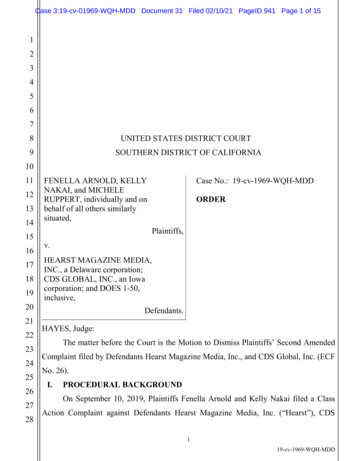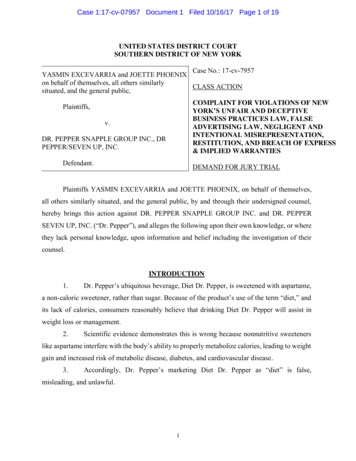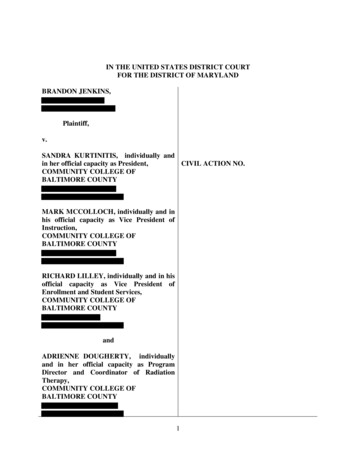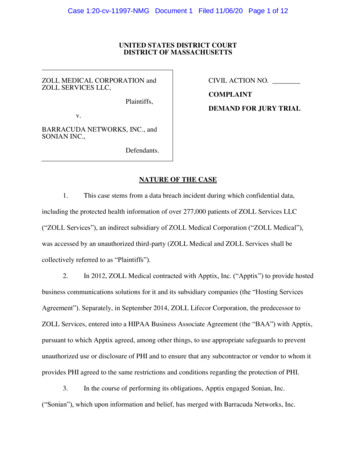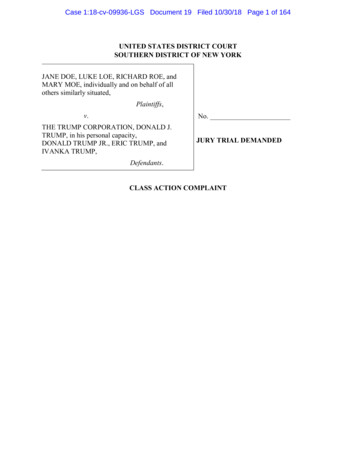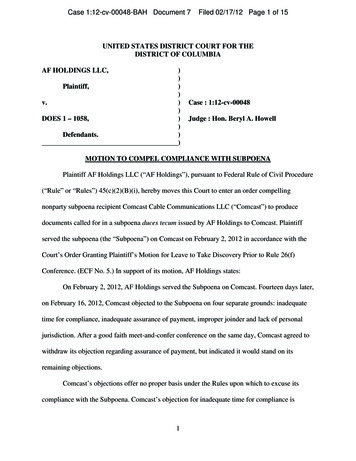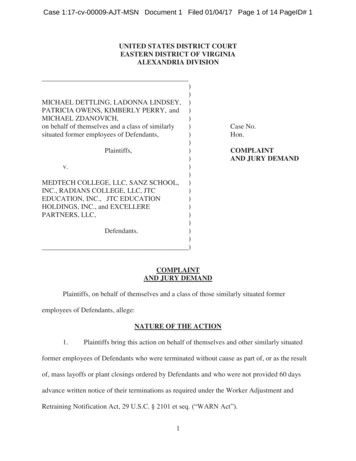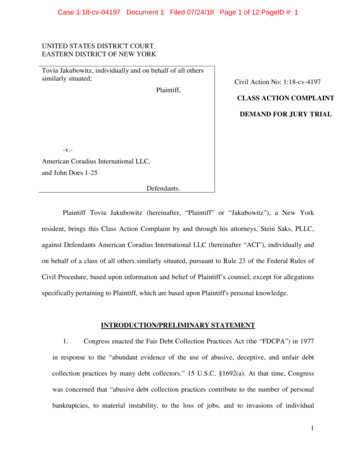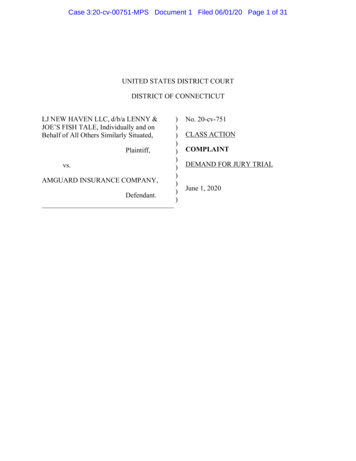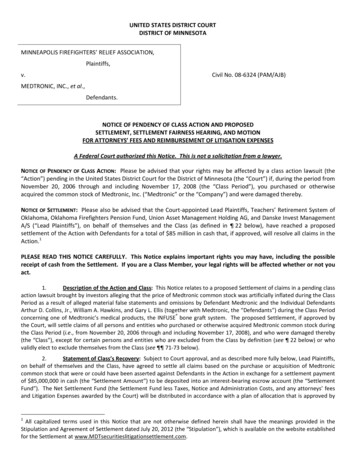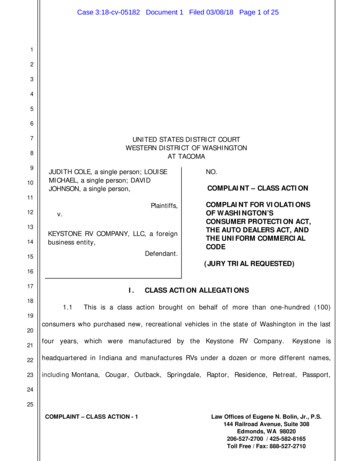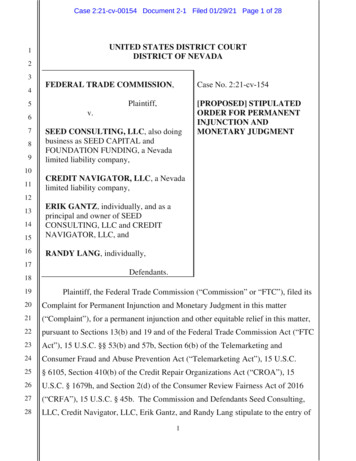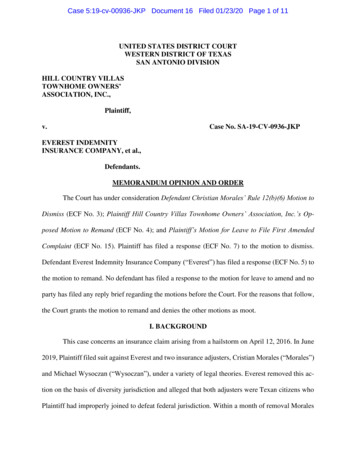
Transcription
Case 5:19-cv-00936-JKP Document 16 Filed 01/23/20 Page 1 of 11UNITED STATES DISTRICT COURTWESTERN DISTRICT OF TEXASSAN ANTONIO DIVISIONHILL COUNTRY VILLASTOWNHOME OWNERS’ASSOCIATION, INC.,Plaintiff,v.Case No. SA-19-CV-0936-JKPEVEREST INDEMNITYINSURANCE COMPANY, et al.,Defendants.MEMORANDUM OPINION AND ORDERThe Court has under consideration Defendant Christian Morales’ Rule 12(b)(6) Motion toDismiss (ECF No. 3); Plaintiff Hill Country Villas Townhome Owners’ Association, Inc.’s Opposed Motion to Remand (ECF No. 4); and Plaintiff’s Motion for Leave to File First AmendedComplaint (ECF No. 15). Plaintiff has filed a response (ECF No. 7) to the motion to dismiss.Defendant Everest Indemnity Insurance Company (“Everest”) has filed a response (ECF No. 5) tothe motion to remand. No defendant has filed a response to the motion for leave to amend and noparty has filed any reply brief regarding the motions before the Court. For the reasons that follow,the Court grants the motion to remand and denies the other motions as moot.I. BACKGROUNDThis case concerns an insurance claim arising from a hailstorm on April 12, 2016. In June2019, Plaintiff filed suit against Everest and two insurance adjusters, Cristian Morales (“Morales”)and Michael Wysoczan (“Wysoczan”), under a variety of legal theories. Everest removed this action on the basis of diversity jurisdiction and alleged that both adjusters were Texan citizens whoPlaintiff had improperly joined to defeat federal jurisdiction. Within a month of removal Morales
Case 5:19-cv-00936-JKP Document 16 Filed 01/23/20 Page 2 of 11filed his motion to dismiss, which Plaintiff quickly followed with its motion to remand. Plaintiffthereafter filed its motion for leave to amend. The motions are ripe for ruling.II. JURISDICTIONThere is no dispute that Morales is a nondiverse party.1 And “as long as a nondiverse partyremains joined, the only issue the court may consider is that of jurisdiction itself.” Int’l EnergyVentures Mgmt., L.L.C. v. United Energy Grp., Ltd., 818 F.3d 193, 209 (5th Cir. 2016). Federalcourts always have “jurisdiction to determine [their] own jurisdiction.” United States v. Ruiz, 536U.S. 622, 622 (2002). “This limited authority permits the court to grant a motion to remand if anondiverse party is properly joined,” while also permitting “the court to deny such a motion if aparty is improperly joined and, in so doing, to dismiss the party that has been improperly joined.”Int’l Energy, 818 F.3d at 209. Regardless, “the focus of the inquiry must be on the joinder, not themerits of the plaintiff’s case.” Smallwood v. Ill. Cent. R.R. Co., 385 F.3d 568, 573 (5th Cir. 2004)(en banc). “In considering whether a nondiverse party was improperly joined under Smallwood,the court is only considering jurisdiction.” Int’l Energy, 818 F.3d at 210.Given the jurisdictional concerns presented by the alleged improper joinder, the Court firstaddresses the motion to remand, which falls within its limited authority to determine its own jurisdiction over this removed case.III. MOTION TO REMANDThrough the motion to remand, Plaintiff argues that this case involves no improper joinder2and that the presence of a local defendant precludes diversity jurisdiction and requires remand.In general, “any civil action brought in a State court of which the district courts of the1In response to the motion to remand, Everest now contends that Wysoczan is a diverse defendant. Rather than determine his state citizenship, the Court will focus on the undisputed nondiverse defendant.Some jurisdictions use the phrase, “fraudulent joinder,” but this Court will use “improper joinder” as generally usedin the Fifth Circuit. See Mumfrey v. CVS Pharmacy, Inc., 719 F.3d 392, 401 n.14 (5th Cir. 2013).22
Case 5:19-cv-00936-JKP Document 16 Filed 01/23/20 Page 3 of 11United States have original jurisdiction, may be removed by the defendant or the defendants, tothe district court of the United States for the district and division embracing the place where suchaction is pending.” 28 U.S.C. § 1441(a). There is no dispute, furthermore, that 28 U.S.C. § 1332(a)provides the federal courts with original jurisdiction over all civil actions between “citizens ofdifferent States” when the amount “in controversy exceeds the sum or value of 75,000, exclusiveof interest or costs.” However, a “civil action otherwise removeable solely on the basis of thejurisdiction under section 1332(a) of this title may not be removed if any of the parties in interestproperly joined and served as defendants is a citizen of the State in which such action is brought.”See id. § 1441(b)(2).A party may move to remand a previously removed case. See 28 U.S.C. § 1447(c). “Because removal raises significant federalism concerns, the removal statute is strictly construed ‘andany doubt as to the propriety of removal should be resolved in favor of remand.’” Gutierrez v.Flores, 543 F.3d 248, 251 (5th Cir. 2008) (quoting In re Hot-Hed, Inc., 477 F.3d 320, 323 (5thCir. 2007)). “Any ambiguities are construed against removal and in favor of remand to state court.”Mumfrey v. CVS Pharmacy, Inc., 719 F.3d 392, 397 (5th Cir. 2013). The removing party has theburden to show “that federal jurisdiction exists and that removal was proper.” Scarlott v. NissanN. Am., Inc., 771 F.3d 883, 887 (5th Cir. 2014) (quoting Mumfrey, 719 F.3d at 397).Everest removed this case solely on the basis of diversity jurisdiction. No party raises adispute about the jurisdictional amount required for diversity jurisdiction, but they disagree as towhether Plaintiff properly joined Morales.There are two ways to establish improper joinder: “(1) actual fraud in the pleading of jurisdictional facts, or (2) inability of the plaintiff to establish a cause of action against the nondiverse party in state court.” Smallwood v. Ill. Cent. R.R. Co., 385 F.3d 568, 573 (5th Cir. 2004)3
Case 5:19-cv-00936-JKP Document 16 Filed 01/23/20 Page 4 of 11(en banc); accord Int’l Energy Ventures Mgmt., L.L.C. v. United Energy Group, Ltd., 818 F.3d193, 199 (5th Cir. 2016) (stating the two ways as “(1) the plaintiff has stated a claim against adiverse defendant that he fraudulently alleges is nondiverse, or (2) the plaintiff has not stated aclaim against a defendant that he properly alleges is nondiverse”). This case only concerns thesecond method.To successfully show improper joinder under the second method, a defendant must demonstrate “that there is no possibility of recovery by the plaintiff against an in-state defendant,” whichmeans that the defendant must show that “there is no reasonable basis for the district court topredict that the plaintiff might be able to recover against an in-state defendant.” Mumfrey, 719 F.3dat 401 (citations and emphasis omitted); accord Int’l Energy, 818 F.3d at 200 (substituting “nondiverse” for “in-state”); Smallwood, 385 F.3d at 573 (adopting “this phrasing of the required proofand reject[ing] all others, whether the others appear to describe the same standard or not”). TheFifth Circuit consistently reiterates that a claim of improper joinder fails when there is “a reasonable possibility of recovery, not merely a theoretical one.” Kling Realty Co. v. Chevron USA, Inc.,575 F.3d 510, 513 (5th Cir. 2009) (quoting Campbell v. Stone Ins., Inc., 509 F.3d 665, 669 (5thCir. 2007)); accord Smallwood, 385 F.3d at 573 n.9 (agreeing that a “‘mere theoretical possibilityof recovery under local law’ will not preclude a finding of improper joinder”).When considering the issue of improper joinder, the Court’s task is not to determinewhether the plaintiff will recover on any claim asserted against the adjuster or whether the plaintiffis even likely to recover; the Court instead must only consider whether there is a reasonable basisto predict that the plaintiff might be able to recover on any claim asserted against a nondiversedefendant. See Smallwood, 385 F.3d at 573; Mumfrey, 719 F.3d at 401. At this stage of the litigation, the plaintiff has no need to prove any claim. See Johnson v. Zurich Am. Ins. Co., No. 3:11-4
Case 5:19-cv-00936-JKP Document 16 Filed 01/23/20 Page 5 of 11CV-0344-P, 2011 WL 3111919, at *4 (N.D. Tex. June 29, 2011).While the Court’s inquiry is on the joinder rather than the merits of any particular claim,Smallwood, 385 F.3d at 573, the federal courts apply one of two alternate federal tests – one premised on Fed. R. Civ. P. 12(b)(6) and the other premised on piercing the pleadings by conducting asummary inquiry, see Int’l Energy, 818 F.3d at 207. But courts use both inquiries “to resolve theissue of jurisdiction, not merits.” See id. at 210. Furthermore, “the existence of even a single validcause of action against in-state defendants . . . requires remand of the entire case to state court.”Gray ex rel. Rudd v. Beverly Enters.-Miss., Inc., 390 F.3d 400, 412 (5th Cir. 2004); accord Allenv. Walmart Stores, L.L.C., 907 F.3d 170, 183 (5th Cir. 2018).No one disputes that Texas law permits actions against an adjuster. And, undoubtedly, insurance adjusters are subject to liability under Chapter 541 of the Texas Insurance Code. See Gaschv. Hartford Accident & Indem. Co., 491 F.3d 278, 281-82 & n.2 (5th Cir. 2007) (applying predecessor statute of the current § 541.060 of the Tex. Ins. Code while noting the amendments did notchange the legal standards); Marminco III Family, L.P. v. Arch Specialty Ins. Co., No. EP-17-CV311-KC, 2017 WL 7797711, at *2 (W.D. Tex. Dec. 19, 2017); Liberty Mut. Ins. Co., v. GarrisonContractors, Inc., 966 S.W.2d 482, 486 (Tex. 1998). The question is not whether an adjuster issubject to liability in a general sense, but whether the adjuster “has committed some act that isprohibited by the Texas Insurance Code.” Marminco III Family, L.P., 2017 WL 7797711, at *2(citing Hornbuckle v. State Farm Lloyds, 385 F.3d 538, 545 (5th Cir. 2004); Messersmith v. Nationwide Mut. Fire Ins. Co., 10 F. Supp. 3d 721, 724 (N.D. Tex. 2014)).Plaintiff asserts claims directly against Morales, including claims for unfair settlementpractices under § 541.060 of the Texas Insurance Code. See Pl.’s Orig. Pet. (attached as part ofEx. B of Notice of Removal (ECF No. 1) ¶ 51. And it lists the following alleged violations of that5
Case 5:19-cv-00936-JKP Document 16 Filed 01/23/20 Page 6 of 11section: (1) misrepresenting one or more material facts and/or policy provisions relating to coverage (§ 541.060(a)(1)); (2) failing to attempt in good faith to effectuate a prompt, fair, and equitablesettlement of claims with respect to which their liability had become reasonably clear (§541.060(a)(2)(A)); (3) failing to attempt in good faith to effectuate a prompt, fair, and equitablesettlement of a claims under one portion of a policy with respect to which liability had becomereasonably clear in order to influence Plaintiff to settle its claims with respect to another portionof the policy (§ 541.060(a)(2)(B)); (4) failing to promptly provide a reasonable explanation of thebasis in law or fact for the denial of Plaintiff’s claims (§ 541.060(a)(3)); (5) refusing to affirm ordeny coverage within a reasonable time (§ 541.060(a)(4)(A)); (6) refusing to conduct a reasonableinvestigation; (7) ignoring damage known to be covered by the insurance policy; and/or (8) conducting an outcome-oriented investigation in order to provide Everest with a basis to underpay theclaims. See id. As indicated by the parentheticals included in the above list, many of these allegedviolations merely parrot provisions of Tex. Ins. Code § 541.060(a). But Plaintiff provides supporting facts in the paragraphs that follow the listing. See id. ¶¶ 52-59.The parties disagree about what particular claims may be pursued independently againstan insurance adjuster. Because Plaintiff need assert only one claim that it can possibly sustainagainst Morales, the Court will focus on the claimed violations of Tex. Ins. Code § 541.060(a)(2).Neither party relies on any Texas opinion to show whether such a claim might lead to recoveryagainst an adjuster. Plaintiff focuses on federal decisions that have found a reasonable basis for apotential recovery against an insurance adjuster while recognizing that some courts have declinedto find such a reasonable basis. On the other hand, Everest relies solely on federal decisions thathave found no such reasonable basis.Indeed, some courts have found that § 541.060(a)(2) provides no basis for a claim against6
Case 5:19-cv-00936-JKP Document 16 Filed 01/23/20 Page 7 of 11an insurance adjuster because adjusters lack settlement authority. See, e.g., Lopez v. United Prop.& Cas. Ins. Co., 197 F. Supp. 3d 944, 950 (S.D. Tex. 2016); Messersmith, 10 F. Supp. 3d at 724;One Way Invests., Inc. v. Century Sur. Co., No. 3:14-CV-2839-D, 2014 WL 6991277, at *4 (N.D.Tex. Dec. 11, 2014). Other courts disagree with that interpretation on grounds that “such a readingunduly narrows the scope of the provision.” See Roach v. Vehicle, No. 3:15-CV-3228-G, 2016 WL795967, at *5 (N.D. Tex. Feb. 29, 2016); Linron Prop., Ltd. v. Wausau Underwriters Ins. Co., No.3:15-CV-293-B, 2015 WL 3755071, at *5 (N.D. Tex. June 16, 2015). Thus, some courts haveremanded cases on the basis of an asserted § 541.060(a)(2) claim. See, e.g., Mehar Holdings, LLCv. Evanston Ins. Co., No. 5:16-CV-491-DAE, 2016 WL 5957681, at *4 (W.D. Tex. Oct. 14, 2016);Shade Tree Apts. v. Great Lakes Reins. (UK) PLC, No. A-15-CA-843-SS, 2015 WL 8516595, at*4-5 (W.D. Tex. Dec. 11, 2015); Linron Prop., Ltd., 2015 WL 3755071, at *5.After reviewing various opinions on both sides of this issue, the Court concludes that differing federal opinions on similar facts create a sufficient reasonable possibility for recoveryagainst a nondiverse insurance adjuster under Tex. Ins. Code § 541.060(a)(2). Many legal principles support this conclusion. First, the party asserting improper joinder carries a heavy burden ofpersuasion. Travis v. Irby, 326 F.3d 644, 649 (5th Cir. 2003). And when determining “the validityof an improper joinder claim,” the courts “evaluate all of the factual allegations in the light mostfavorable to the plaintiff, resolving all contested issues of substantive fact” and “all ambiguities inthe controlling state law in the plaintiff’s favor.” Guillory v. PPG Indus., Inc., 434 F.3d 303, 308(5th Cir. 2005). Only after the Court resolves “disputed questions of fact and all ambiguities in thecontrolling state law in favor of the non-removing party,” does it “determine whether that partyhas any possibility of recovery against the party whose joinder is questioned.” Hart v. Bayer Corp.,199 F.3d 239, 246 (5th Cir. 2000) (citation and emphasis deleted). Still, the Court remains mindful7
Case 5:19-cv-00936-JKP Document 16 Filed 01/23/20 Page 8 of 11that a reasonable possibility of recovery requires more than a “mere hypothetical possibility thatsuch an action could exist.” Griggs v. State Farm Lloyds, 181 F.3d 694, 701 (5th Cir. 1999).3At this point, the Court need not determine whether one side or the other is correct. Itinstead agrees that “such a split in authority must be resolved in favor of remand because, in thecontext of a motion to remand, ‘[a]ny ambiguities are construed against removal and in favor ofremand to state court.’” Marminco III Family, L.P., 2017 WL 7797711, at *4 (quoting Hood exrel. Miss. v. JP Morgan Chase & Co., 737 F.3d 78, 84 (5th Cir. 2013)); accord River of LifeAssembly of God v. Church Mut. Ins. Co., No. 1:19-CV-49-RP, 2019 WL 1767339, at *4 n.3 (W.D.Tex. Apr. 22, 2019); Fairway Leasing, LLC v. Nationwide Mut. Ins. Co., No. SA-17-CA-752-XR,2017 WL 7693373, at *3 (W.D. Tex. Oct. 4, 2017); Mehar Holdings, LLC., 2016 WL 5957681, at*4; Shade Tree Apts., 2015 WL 8516595, at *6.Some claims by their very nature or the underlying facts may provide no reasonable prospect for recovery against an adjuster. Some may amount to no more than a hypothetical possibilityfor a viable cause of action. If a plaintiff only asserts either of those types of claims against anadjuster, the federal courts should find the joinder improper and deny the motion to remand. Butwhen there is sufficient ambiguity in the controlling state law, federal courts are directed to construe the ambiguity in favor of the plaintiff. Therefore, with respect to Plaintiff’s claim againstMorales under Tex. Ins. Code § 541.060(a)(2), the Court finds that Plaintiff has alleged a cause ofaction that creates a reasonable possibility for recovery against a nondiverse insurance adjuster.When a plaintiff “has properly alleged at least one cause of action under which” a nondiverse defendant insurance adjuster may be held liable, the next question is whether the plaintiffhas alleged enough facts to support such claim. Marminco III Family, L.P., 2017 WL 7797711, atA “mere hypothetical possibility” equates to the theoretical possibility that Smallwood expressly recognized as insufficient to preclude a finding of improper joinder.38
Case 5:19-cv-00936-JKP Document 16 Filed 01/23/20 Page 9 of 11*4. The parties invoke the Rule 12(b)(6)-type analysis to determine whether joinder was proper.Such analysis incorporates the federal pleading standard. Int’l Energy, 818 F.3d at 200.Under Fed. R. Civ. P. 12(b)(6), litigants may move to dismiss asserted claims for “failureto state a claim for which relief can be granted.” Plaintiffs must provide “more than labels andconclusions, and a formulaic recitation of the elements of a cause of action will not do.” Bell Atl.Corp. v. Twombly, 550 U.S. 544, 555 (2007); accord Ashcroft v. Iqbal, 556 U.S. 662, 678 (2009).Facts alleged by the plaintiff must “raise a right to relief above the speculative level.” Twombly,550 U.S. at 555. To survive a Rule 12(b)(6) motion, the complaint must plead “enough facts tostate a claim to relief that is plausible on its face.” Id. at 570.A claim has facial plausibility when the plaintiff pleads factual content that allowsthe court to draw the reasonable inference that the defendant is liable for the misconduct alleged. The plausibility standard is not akin to a “probability requirement,” but it asks for more than a sheer possibility that a defendant has acted unlawfully. Where a complaint pleads facts that are “merely consistent with” a defendant’s liability, it “stops short of the line between possibility and plausibility of‘entitlement to relief.’”Iqbal, 556 U.S. at 678 (citations omitted). To avoid dismissal under Rule 12(b)(6), plaintiffs mustallege facts that “nudge” an asserted claim “across the line from conceivable to plausible.”Twombly, 550 U.S. at 570.Plaintiff alleges that Morales did not conduct his own independent investigation of theinsurance claim, but instead inspected the property with a biased engineer so as to justify the initialdenial of coverage. Pl.’s Orig. Pet. ¶ 16. It further alleges that Morales participated in a telephonecall in which he, Wysoczan, and the engineer agreed to have a follow-up conversation; Moralesstated that those three would discuss an estimate; and Everest would then respond within twoweeks, but forty-nine days later the two adjusters declined coverage in a three-page letter thatrubberstamped prior findings. Id. ¶ 18.9
Case 5:19-cv-00936-JKP Document 16 Filed 01/23/20 Page 10 of 11As already mentioned, Plaintiff asserts specific claims against Morales based on unfairsettlement practices under Tex. Ins. Code § 541.060. Id. ¶ 51. To specifically support such claims,Plaintiff has alleged that Morales inspected the property; ignored covered damage and refused toaddress all damages caused by the loss; used a biased engineer instead of conducting an independent investigation; withheld a supplemental report without approval from the insurance company;made a statement during the above-mentioned telephone call that led Plaintiff to believe defendantswere attempting to amicably resolve the insurance claim by providing an estimate of damages;delayed a declination letter; and failed to request
Jan 23, 2020 · Plaintiff has filed a response (ECF No. 7) to the motion to dismiss. Defendant Everest Indemnity Insurance Company (“Everest”) has filed a response (ECF No. 5) to the motion to remand. No defendant has filed a response to the motion for leave to amend and no party has filed any reply brief regarding the motions before the Court.
